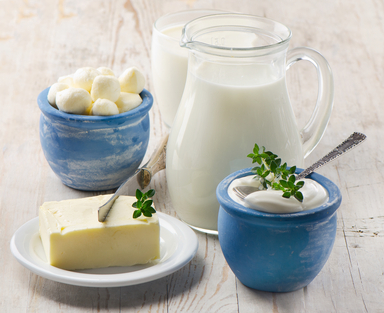Dairy. Do? Or, Don’t?
 It’s a new year, we’re past the holidays and those resolutions to eat better may be confusing. Where do you start? And what should you give up first? Sugar? Grain products? Fats?
It’s a new year, we’re past the holidays and those resolutions to eat better may be confusing. Where do you start? And what should you give up first? Sugar? Grain products? Fats?
Whoa! Hold on there, because what I’m about to share may rock your world when it comes to thinking about fats.
When I think about fatty foods, one of the first things I think about are dairy products. Yet, research shows that dairy intake is below the recommended level, despite well-established recommendations and of course, their contribution to bone health. What’s more, it appears that eating dairy products may actually lower the risk for metabolic syndrome — the constellation of conditions such as obesity, glucose intolerance, high blood pressure and high cholesterol — that together lead to diabetes, coronary artery disease and stroke. A scary related fact is that metabolic syndrome affects more than a third of women after the age of 55, and has been linked with hormonal changes that occur during menopause (check out the metabolic syndrome posts in the Archives).
In a review in the January online edition of Maturitas, Canadian researchers share a few important facts about dairy products and why you may want to reconsider their role in your diet:
- Obesity. Contrary to popular belief, eating dairy may actually protect against weight gain. While this appears to be counterintuitive, research has shown that dairy may have a beneficial effect on the way that the body breaks down sugar and converts it to fat for storage, and instead, promote the breakdown of fats. Calcium also appears to help the body break down large fat molecules so that the fat is more readily available for energy. And, whey protein appears to help preserve muscle, while lactose and dairy proteins may boost the feeling of fullness. What’s more, eating dairy may actually help reduce that tire around your midsection. However, like any dietary rule of thumb, too much is too much. Dairy intake should be limited to two to three servings a day and products should be consumed along with a balanced diet.
- Blood sugar. While the evidence is still being teased out, dairy may help to keep blood sugar levels in check by preventing insulin sensitivity, that is, balancing the way that insulin is produced and the cells’ reaction to it (when cells lose their sensitivity to insulin, diabetes results).
- Fat in, fat out. Dairy products have long been linked to saturated fat, which has been shown to increase the risk for heart disease. Yet, in moderation, whole fat dairy may actually help balance cholesterol and blood fats levels and even boost good cholesterol – HDL – levels. Still, this is not a free pass for eating all the whole dairy products that your heart desires; everything in moderation. In other words, if your daily intake includes a serving of whole dairy, you need to compensate elsewhere in your diet.
- Blood pressure. Data suggest that consumption of 3 servings a day of low-fat dairy products may actually reduce the risk of high blood pressure by roughly 16%. The best choices appear to be ‘fluid dairy’ (i.e. milk and yogurt) rather than cheese. While researchers are uncertain how dairy yields a protective effect on blood pressure, it may be due to their action on the cells that line blood and lymphatic vessels. Among their various function, these cells, better known as the endothelium, help keep the blood pressure in check.
- Inflammation. Increasingly, low grade inflammation in the body is being linked to disease. In fact, it is considered a key factor in the development and progression of metabolic syndrome. Certain components in dairy may actually reduce blood markers of oxidative stress and inflammation.
I asked my friend and colleague, and registered dietician/nutritionist extraordinaire Danielle Omar to weigh in on dairy and whether there is any advantage to using low fat versus full fat products. She says that she’s “not a huge fan of fat free dairy products, especially skim milk. The fat in milk helps with the absorption of fat soluble vitamins (A, D, E, K) and other nutrients that can only be assimilated into the body when eaten with fat,” adding that it’s likely that “choosing more fat free vs whole fat dairy will cause weight gain over time.” The reason? People tend to eat more low- versus full-fat dairy before they are satisfied. Moreover, some of the low-fat dairy products are very high in sugar and without fat to slow digestion can cause insulin spikes/hunger crashes — can lead to overeating. Danielle also says that “people tend to overeat low-fat foods because they think they are being “healthy.”
Dairy? Do! Just be certain to balance it out with other healthy items in your diet.
Read MoreWhat’s the latest on calcium supplements?
Calcium. Lord knows that both men and women need calcium for bone health. However, women in particular start to lose bone density as early as age 35 and, within the first 10 years of the onset of menopause, up to 50% of spongy, or trabecular bone (the network that makes up most of bone structure) and up to 30% of cortical bone (the outer shell) are also lost.
Despite its importance to bone health, there is a lot of controversy surrounding calcium, particularly when it comes to the recommended dietary allowance or RDA. Currently, the Institute of Medicine recommends that women between the ages of 19 and 50 ingest at least 1,000 mg a day and those over 50, 1,200 mg a day. Still, too much of a good thing is too much; an overreliance on supplementation (often as a result to avoid milk, yogurt, cheese and other dairy products) may increase the risk for heart disease and kidney stones.
In a review in the journal Menopause, researchers note that women who rely on supplements for their daily calcium needs more often than not take doses that exceed the RDA. The reason that this is problematic is that our bodies cannot absorb more than 500 mg daily of calcium from either food or supplements in any two-hour period, so if you are eating calcium rich foods (which in addition to the aforementioned dairy also includes canned fish with bones, tofu, calcium-fortified products, broccoli, collards and kale), also adding a daily supplement may take you to a place that you want to avoid. Importantly, while higher dietary calcium from food actually appears to reduce kidney stone formation and may even offer protection from heart disease, the opposite is true for supplements:
- In the Women’s Health Initiative study, exceedingly high intake of calcium (from a combination of diet and supplements) was shown to increase the risk for kidney stones by 17%.
- While the link between calcium supplements and heart disease is still being teased out, findings from a large review concluded that they raised the risk for heart attack by as much as 30%.
What should you do?
- Obtain as much calcium as you can from your diet to meet recommended daily goals and only take supplements if this is impossible or if recommended by your health practitioners.
- Contrary to popular belief, the RDA goal for calcium can often be reached by taking only 500 mg daily of calcium via supplement.
- If you are going to rely on calcium supplements, form matters. Researchers believe that calcium citrate may be less likely to cause kidney stones than calcium carbonate. And as I wrote back in 2009, there may be an advantage to a form of calcium known as ossein-hydroxyapatite complex (OHC), which is the mineral component of bones and teeth (OHC goes by the brand name of MCHA or MCHC and is easily found on the web).
Read More
New Year? New You!
Want to know one of the most important resolutions that you can make? Commit to you!
I write about a lot of topics on Flashfree but the overriding theme is health and the importance of taking care of yourself. And no one can do that better than you can, that is, once you make a commitment to become healthier and identify strategies that work best for you. There are four tips that I’d like to offer to help you get over the initial hump.
- Move. I can’t emphasize the importance of physical activity enough. From bone health to heart health to mental health, it is the one accessible, equal opportunity strategy, regardless of income or geography. Because even if you don’t have entry to the gym, you can walk, run, bike, step, or engage in other activities that don’t require a membership or a monthly fee. In addition to counterbalancing the calories that you ingest daily, simply simply engaging in vigorous physical activity, i.e. 7 days of a combination of moderate intensity/intense activities that add up to 3000 MET minutes a week) can significantly decrease menopausal symptoms, in particular fatigue, depression, insomnia and hot flashes. (Activity level is scientifically measured by units known as METs, or metabolic equivalents; vigorous activity is equivalent to 8 METs and moderate activity to 4 METs).
- Be conscious. My grandmother used to say ‘everything in moderation.’ When it comes to diet, I don’t engage or believe in deprivation but I do try to balance out the occasional junk and sweets with healthy, daily doses of vegetables, fresh fruit, lean proteins and fiber. Researchers say that what you eat is extremely important. In a study of over 500 women, the strategy that worked best, leading to an average weight loss of 17 pounds over six months, entailed boosting intake of soluble fiber, fruits, veggies, whole grains and sources of plant stanols/sterols (i.e. almonds, brussel sprouts, wheat germ/bran, peanuts, olive oil and omega-3s). However, they also started moving more and adding regular, moderately intense activity to their daily routines.
- Engage. Want to know the key to health and wellbeing? Your friends. Data from a study published in Psychological Review in 2000 suggests that women’s inherent response to stress is to ‘tend and befriend’ rather than ‘fight or flight;’ in other words, there is a biologically-defined strategy or pattern that involves caring for offspring, joining social groups, and gravitating towards friends under stressful circumstances. This is driven, at least in part, by the release of the hormone oxytocin, which coupled with endogenous opioids and other sex hormones, promotes maternal behavior as an alternative to the male-oriented fight and flee response. Other findings have also shown that friendships help prevent the development of physical impairment and facilitate a more joyful existence. What’s more, having a strong social network can lower blood pressure and heart rate and improve cholesterol levels. The bottom line? Nature has provided us with a built-in prompt to maintain those ever important bonds. Our inherent tendency to nurture completes the picture.
- Laugh. Several years ago, researchers discovered that humor therapy and anticipation of laughing or being amused (also known as mirthful laughter) boosts mood hormones and raises human growth hormone (which optimizes immunity levels. Mirthful laughter has been shown to lower stress hormones and improve the functioning of certain cells – natural killer cells – that favour immune function. Daily laughter also helps lower cholesterol, decreases inflammation that contributes to disease and improves overall wellness. A good belly laugh goes an awfully long way. That funny bone? Seek it out.
Not a creature was stirring…
Wishing you and yours’ joy this holiday season! See you in 2014!
Read More
Best (and worst) of 2013? You decide!
It’s that time of year again when I start polling readers about Flashfree (and Guyside) — what you liked, what you disliked, what I/we can be doing better. So, I’m throwing it out there – share a link to the post that resonated the most, and that resonated the least, in the comments section. Tell me and my colleague Bob Le Drew what you would like to see more and less of in 2014. And don’t forget that we start a weekly Guyside in the New Year.
Your reward for your comments? a $25 Amazon gift card which will be drawn out of a hat on January 1.
Ready! Set! Soapbox….
Read MoreNewsflash: MedPage Today warns about OTC thyroid supplements
I’ve long been asked to write about thyroid issues and I’ve avoided the topic for several reasons, one of which is that it can be quite complicated to distinguish between common perimenopausal and menopausal symptoms such as fatigue, weight changes and hair loss and the very same that may be related to an underactive thyroid. Other symptoms may include changes in cognitive function (memory issues, anyone?) and depression.
A bit of background…
As we age, thyroid disorders become more pervasive. This is due to functional changes in the endocrine system — the collection of glands the produce hormones that control growth, metabolism, sexual development and function (including the thyroid gland) — that result in certain tissues and glands producing less of a certain hormone or producing it at a slower rate. The thyroid in particular, can cause problems because signs are not always readily apparent. And when they are caught, they may be easily confused with the most common complaints of menopause, which is why the involvement of a healthcare professional is so critical.
Yet, MedPage Today is reporting that women who take over the counter supplements to boost thyroid function may actually be placing themselves at risk for severe hyperthyroidism, a condition in which the thyroid produces too much hormone, which can lead to rapid weight loss, irritability and nervousness, sweating, fatigue and a rapid heartbeat. The underlying reason for the associated risk in OTCs is that they contain unlabeled levels of two main thyroid hormones — T4 (thyroxine), and T3 (trilodothyronine).
The article also points to other contaminants, such as iodine and heavy metals.
I encourage you to visit MedPage Today (you may need to register) and read the piece. as Staff Writer Kristina Fiore’s expert source points out, it is especially critical for women who are looking for a quick fix for their thyroid issues to avoid supplements at all cost and see a physician who will monitor and measure hormone levels to insure that they are just right. These drugs walk a fine line when it comes to dosing and the gap between an effective dose and a lethal one is quite narrow.
If you are uncertain about your symptoms and you are not finding relief with standard menopause therapy strategies, please see a qualified endocrinologist. You may be mistaking menopause for something more serious but often equally manageable by a health professional.
Read MoreGuyside: Don’t let winter weigh you down

There may not be a five-mile skating rink like Ottawa’s Rideau Canal in your town. But there are lots of opportunities for physical activity, even when the days are short and temperatures drop.
Where I live, this is the darkest time of the year. Instead of a beautiful sunrise when I wake up, it’s dark. When my partner is walking home from her office, it’s also dark. The layers of clothing get added to. The gloves and the puffy jackets come out of the basement. And the road bike gets brought inside and put on the trainer. Even though the winter solstice in December marks the is a welcome “bottom” to the year, before and after, the days are dark and short and cold.
When I was a kid, winter was the time for snow forts and snowmen and skating in the community rink while Anne Murray tunes scratched over the PA system.
Now, winter is the time of year where I have to shovel the driveway, wear heavy boots that I don’t like, and the time when I can’t ride (I know I could ride, but I’ve never been a winter cyclist type).
When it’s snowy and cold, It’s easy to find that hot new series to watch, to light a fire, pop some popcorn, and wait for spring. It’s just too tempting to simply hibernate in the house over the winter months. And it’s also a terrible idea when it comes to men’s health.
In Canada, studies show that people are nearly twice as likely to participate in any physical activity in summer compared to winter. And if you look at the sporting activities Canadians participate in, only two of the top 10 are winter sports. In Canada, it shouldn’t be surprising to anyone that ice hockey bumps up winter sports participation numbers, and even with the burgeoning popularity of women’s hockey it’s still predominantly male.
And the irony of all this is that when you exercise outdoes in the winter you burn up to 31% more calories than in warmer weather.
So, some tips for guys like me who don’t play hockey or ski for getting out there:
- “There’s no bad weather, just bad clothing” is an a age-old proverb. So if you’re going to invest, invest in good layers of clothing. Go to a store that specializes in outdoor gear for winter so that you can benefit from knowledgeable staff. Fitness magazine has some tips on how to dress for outdoor exercise.
- If you’re a beer-league hockey player, don’t just rely on the hockey to keep you fit. The start-stop nature of hockey can be dangerous for people who don’t have a good base of fitness.
- Some sports — hockey and skiing come to mind — can be pricey to participate in. But skates and snowshoes are cheaper than fully kitting out for playing hockey or going downhill, and walking (with appropriate footwear that will keep you stable) is the cheapest form of all. I live in Ottawa, where for several weeks each year the Rideau Canal turns into a free five-mile skating rink (your hot chocolate will cost you, though). Also, rent before you buy if you aren’t sure if you’re going to stick to a given activity.
- Find a buddy. There will be times when you can’t drag your own sorry butt out for that workout, which is when you need the nagging, cajoling, and potential bribery of a friend to get you going. Use that help, and offer it to your workout buddy.
- If you just can’t stand winter, then bring your sport indoors. My road bike is hooked up to a trainer, so I have the opportunity to ride inside. Other people go to spinning classes to benefit from the motivation of others suffering around them (N.B.: One discovery from spinning — all that sweat that evaporates when you’re riding the bike outside turns into a puddle beneath the bike when you spin. Be warned.)
- Even if you don’t hit the gym in summer, many will offer “winter membership” or monthly memberships.
If your tendency, like mine, is to go to ground when exercising is no longer just a matter of tossing on a t-shirt, shorts, and going, then you, like me, have to just work a little harder to not give in. Besides, drinking that cocoa will feel SO much better if you skated five miles to get it.
Read More










